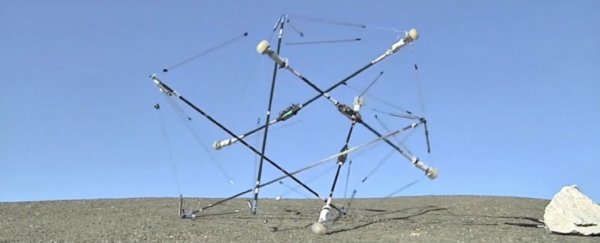
It may look like someone got horribly confused trying to set up their tent in the dark, but this tangle of metal rods and cables is actually a sophisticated robot that could one day be bouncing and rolling across the surfaces of other planets.
The Super Ball Bot, which is being developed by NASA's Innovative Advanced Concepts program, doesn't look anything like a typical rover vehicle.
Instead, the spindly, awkward-looking sphere is what's known as a tensegrity structure. The system is comprised of rigid metal rods, which are connected by flexible joints and elastic cables.
As Liz Stinson explains for Wired:
"This allows the bot to evenly distribute stress and pressure over the entire structure, as opposed to concentrating it on specific joints. The idea is that by adjusting the length of the cables, this flexible robot will be able to roll around the surface of a planet or moon with more speed and resiliency than wheeled robots could even dream about."
Even more important than rolling around is the robot's ability to safely land on a planetary surface, absorbing the shock of a high-velocity impact, which developers say is a key highlight of their unconventional design.
In the below IEEE Spectrum video, two of the developers from NASA discuss the project:

By tuning the stiffness, the Super Ball Bot can become squishy and compliant, and can therefore land on surfaces as most balls do: by bouncing. From there it will deform into a rigid structure and roll to areas of scientific interest.
"If you can survive a hard landing and keep that system you can survive almost anything," explains Adrian Agogino from the NASA Ames Research Centre in the IEEE Spectrum video. "You can go off little cliffs, you can go down steep terrain … it gives you a very secure, robust system."
While it's a long way off, the first target for the Super Ball Bot might be Saturn's largest moon, Titan.
As Evan Ackerman explains for IEEE Spectum, Titan is an ideal testing ground because the "atmosphere and relatively low gravity means that you could drop the robot as-is from orbit without any additional descent paraphernalia and it would make it to the ground completely unscathed".
Of course, NASA has also investigated some alternative landing options, such as dropping the bots from UAVs at lower altitudes, or equipping them with wing-like structures to help them glide.
Another attractive feature of the Super Ball Bot is that it can collapse onto itself, essentially enabling flat-pack transport. Agogino says this means you could send multiple bots in one mission, or else carry out a mission very cheaply
Sources: WIRED, IEEE Spectrum
